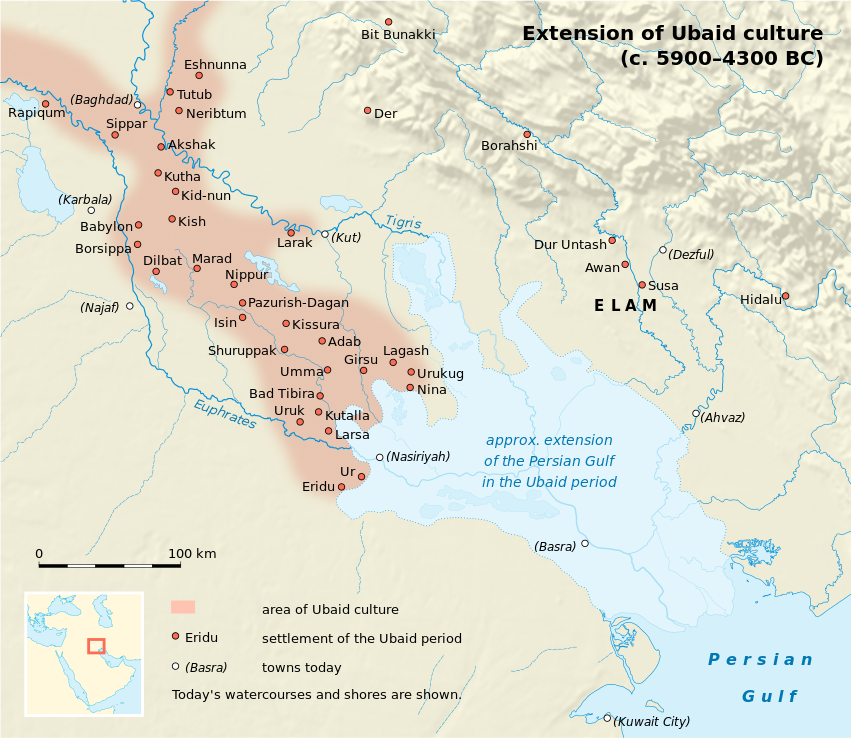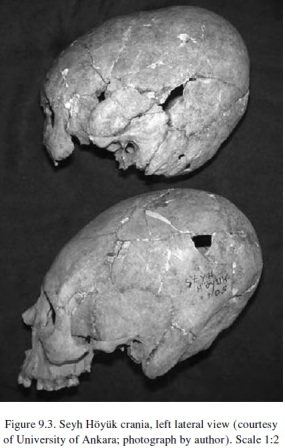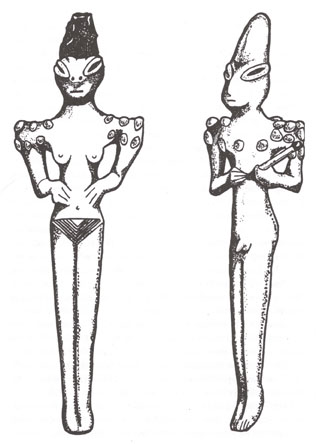Life after Eden must have been a crushing disappointment for early humans, especially the First Couple. Forget about the burden of living under the curse—toiling to coax enough food from the ground to survive, the pain of bringing new life into the world, and all the rest. The realization that they had disappointed their Creator and condemned their children and their children’s children until the end of time to lives apart from Yahweh must have been nearly unbearable.
The Bible gives us very little on the rest of their lives. We only know the names of three of their children: Cain, Abel, and Seth. There must have been others and at least two of them were girls, because Cain and Seth both married and had children of their own. (See? The old question, “Where did Cain find his wife?” isn’t that hard to answer.)
It’s understood that secular archaeologists and historians won’t agree with much of what we believe about human history. That’s okay. We Bible-believing Christians don’t reject science when we interpret data through a biblical lens. Science is the process by which we collect and record information to test theories about the way things are. Analysis is what we do with that information after it’s collected. It’s not the science we often question, it’s the analysis.
Scholars do agree, however, that civilization emerged in the Fertile Crescent around 10,000 B.C. (Note: We’re using dates that are generally accepted by a consensus of scholars so we don’t get bogged down arguing about the timeline. That’s outside the scope of what we’re trying to do here.) Agriculture, cities, writing, trade, science, and organized religion all developed in a broad arc that stretched from Egypt through the Levant and down into Mesopotamia.
This civilization is called the Ubaid culture by scholars. That’s not what the people who lived in it called it, of course; we don’t know what they called themselves because they never invented writing. The Ubaid civilization got its name from Tell al-`Ubaid, a small settlement mound in southeast Iraq where famous archaeologists Henry Hall and Sir Leonard Woolley dug up the first bits of pottery from those people between 1919 and 1924.

This happens a lot with prehistoric cultures. The names of their entire civilizations are accidents of discovery, coming from wherever the first archaeologist, bored shepherd, or greedy tomb raider found the first bit of evidence from people we’d never heard of before. Let’s just hope when archaeologists 8,000 years from now discover the remains of our civilization, it’s not by stumbling across the shell of a Wawa or a Piggly Wiggly.
Archaeologists who study the Ubaid culture agree that it spread from Eridu in southeast Iraq, eventually going as far as what is today northwest Iran, northern Syria, southern Turkey, and the Levant (Syria/Lebanon/Jordan/Israel). The Ubaid civilization was typified by large unwalled villages, rectangular multi-room mud-brick houses, high quality pottery, and the first public temples. Crop irrigation developed by about 5000 B.C., so cereals and grains could grow in the dry climate that again dominated the region. The first city in Mesopotamia, and therefore the oldest city in the world, appeared around 5400 B.C. Although agricultural settlements like Jericho (c. 9000 B.C.) and Jarmo, east of modern-day Kirkuk in Iraq (c. 7100 B.C.) are older, Eridu, located in what is today southeastern Iraq, was remembered by later Sumerians as the first city, with a degree of specialization among its citizens not seen before in other settlements.
The Sumerian King List, dated to about 2100 B.C., records it this way:
After the kingship descended from heaven, the kingship was in Eridu. In Eridu, Alulim became king; he ruled for 28,800 years.1
Interestingly, the Bible may actually support this account.
Cain went away from the presence of the Lord and settled in the land of Nod, east of Eden. Cain knew his wife, and she conceived and bore Enoch. When he built a city, he called the name of the city after the name of his son, Enoch. To Enoch was born Irad, and Irad fathered Mehujael, and Mehujael fathered Methushael, and Methushael fathered Lamech.
Genesis 4:16-18 (ESV), emphasis added
Some scholars, such as Egyptologist David Rohl, believe it’s possible that the “he” in the second sentence refers to Enoch, not Cain. The last word, Enoch, might be a later addition. In that case the builder of the city was Enoch, and the city was named for his son, Irad—hence, Eridu.
To speculate a little further, we can apply a rudimentary translation to the name Alulim and come up with “fourth man” (A = prefix + lu = “man” + lim, a contraction of limmu = “four”). Again, this is speculative and it may be way off base so don’t take it as gospel. But if it’s correct, then Alulim might have been Irad, the “fourth man,” or fourth generation, after creation—Adam, Cain, Enoch, Irad—and the first king of the first city on Earth, Eridu—the city which bore his name.
Regardless of its origins, what is most interesting about Eridu is that besides being the oldest city in Mesopotamia, and possibly the world, is that was also the home of the oldest and largest ziggurat in Mesopotamia. This was the temple of one of the most important gods of the ancient Near East. He was known as Enki to the Sumerians and Ea to the later Akkadians and Babylonians. Enki was the god of the sweet waters needed for life. He was depicted with two streams of water flowing from his shoulders that represented the Tigris and Euphrates rivers, the main sources of fresh water in Mesopotamia.
Along with An (or Anu) the sky god and Enlil, the god of the air, Enki was one of the three most important gods in Sumer. He arrived very early in Sumer from Dilmun, probably the island of Bahrain in the Persian Gulf. In fact, the Sumerians believed Enki personally created Eridu, elevating it from the marshy ground on what was then the shore of the gulf.
Enki was the god of magic, craftsmanship, and wisdom. Although Enlil was the king of the gods, Enki was the keeper of the mes (sounds like “mezz”), decrees of the gods that formed the fundamental concepts and gifts of civilization—everything from religious practices to social interaction to music.
The Babylonian creation myth, the Enuma Elish, describes how everything on Earth came into being through the defeat of the chaos goddess Tiamat by Marduk, son of Enki/Ea, the chief god of Babylon. However, the older Sumerian story credits Enki with giving life to all things, including mankind, and names Enlil the slayer of Tiamat.
The differences in the story are at least partly due to the ebb and flow of power over the centuries. Each city in Mesopotamia had a patron god or goddess. The importance of a deity was, as you’d guess, tied to the fortunes of its city. Just as Eridu was the home of Enki, Enlil was chief deity at Nippur, Inanna (Ishtar) was supreme at Uruk, the sun god Utu was the patron deity of Sippar, and so on. To give you an idea of the incredible amount of time we’re dealing with, Enki ruled in Eridu for about 3,500 years before Marduk replaced Enlil at the head of the Mesopotamian pantheon, an event linked to Babylon’s emergence as the region’s dominant power in the 18th century B.C.
That’s about the same amount of time that’s passed between Moses leading the Israelites out of Egypt and you reading this sentence.
This essay is not in any way a thorough review of life, culture, or religion in ancient Mesopotamia, but there is one more aspect of life in the ancient Near East to call to your attention. It’s something we usually only hear about from fringe pseudo-scholars who blame the phenomenon on extraterrestrials. Scholars—archaeologists and sociologists—have known at least since the late 1940s that people throughout Mesopotamia, before they learned how to write, figured out how to turn their children into coneheads.
It appears, based on human remains dated to between about 10,000 B.C. and 3500 B.C., that cranial deformation was widespread in the Ubaid culture, and Eridu—the world’s first city, possibly built by Cain or his son—was Ground Zero for head shaping. An archaeological dig at Eridu just after World War II discovered about a thousand bodies that were buried during the Ubaid. Of the 206 sets of remains the archaeologists exhumed, “all of the crania had been deformed in one fashion or another.”2
Got that? 206 out of 206. Not a few, and not just the elites. It appears that everybody from every strata of the Eridu culture had a deformed skull.
Now, instead of asking why, the lead archaeologist decided “earth pressure” after burial was the cause—even though none of the skulls were cracked or broken, which would be expected if the deformations had occurred after death.
Evidence of head shaping has been found at sites all over Iraq, southwestern Iran, eastern Turkey, the valleys of the Zagros mountains, and the western shores of the Persian Gulf, dated from 7500 B.C. to about 4000 B.C. After that, the practice seems to disappear.
Hmm. If we place a global flood sometime between 4000 and 3500 B.C….

The big question is why this was even a thing. Please understand that we’re not suggesting that these were genetic mutations or part-human Nephilim, the angel-human hybrids mentioned in Genesis 6 (although the Nephilim would have been around during at least part of this time). But who wakes up one morning in 7000 B.C. and decides to wrap something around baby’s skull to see if it makes his head pointy?
What inspires that? And why was Eridu the starting point for this?
A study published in the academic journal Paléorient in 1992 concluded that the practice of head-shaping, which is found around the world, must have originated in the Near East because it was so widespread there. However, the researchers believed the deformation was not necessarily intentional, but probably “incidental to patterns of head-gear.”3
Really? For more than six thousand years our ancestors accidentally forced their babies to wear head-gear so tight it deformed their skulls?
Here’s another bit of data to chew on. At Eridu and nearby sites in ancient pre-flood southern Sumer, and only there, archaeologists have found about 120 terracotta figurines scholars call “ophidian.” That’s fancy talk for snake-like. They’re slender bipeds, adorned with button-like protuberances, more often female than male, and often in poses that are exclusively mammalian—for example, a female lizard-like figure suckling an infant.

The aforementioned scholars pointed out in their paper that there had been no serious study of those figurines and what they meant to the ancients, and no scholarly literature on the origins of human cranial deformation (at least as of their writing in 1992).
Why might that be?
While there hasn’t been much scholarly attention paid to the snake-like figurines, there have been several papers published within the last ten years on head-shaping in the ancient Near East. Still no conclusions on why or how it got started, but it’s clear that the people who lived in the region—descendants of the refugees from Eden—made a habit of this odd practice.
We’ll never know for sure, but we can speculate: The people who formed the earliest human civilizations copied a look that someone, somewhere had seen and decided was a physical ideal. What motivates modern-day teens to wear the clothes and hairstyles they do? Except that this particular fashion statement didn’t change with the seasons—it appears to have been worn by nearly everybody for more than 6,000 years!
It’s not likely that this was a simple fashion statement. However it started, this was apparently a practice that was believed to convey some advantage.
Think back to what we discussed about the serpentine nachash and seraphim, and remember that at least one of them rebelled against Yahweh. Is it possible that the citizens of the prehistoric Near East were trying to curry favor with a god?
#
Now, if we haven’t already, here is where we may run off the rails. But let’s run through one more theory, look at the evidence, and see if it makes sense.
As mentioned earlier, Eridu is considered by archaeologists to be the center of the Ubaid culture. The Ubaid period is defined as the civilization in the ancient Near East just before the time of Nimrod and the Tower of Babel, roughly between 6500 B.C. and 3800 B.C. It would have begun not long after Adam and Eve got kicked out of the garden.
Now, God wanted humanity to “have dominion over the fish of the sea and over the birds of the heavens and over every living thing that moves on the earth” (Genesis 1:28). It was not for His people to take dominion over each other. As Jesus told his disciples thousands of years later, “You know that the rulers of the Gentiles lord it over them, and their great ones exercise authority over them. It shall not be so among you” (Matthew 20:25-26a).
Just as Adam and Eve were created to work the land, God’s design for humans was to be more or less self-sufficient—growing our own food, tending our own flocks, and helping each other whenever and however we’re needed. When you live that kind of life, you’re too busy to lord it over your neighbors. And, frankly, since you’re not depending on handouts for your family’s daily bread, it’s harder for government to lord it over you. It makes sense that Israel was led by judges in times of trouble during its early years, but a king wasn’t part of the original plan—even though God, who knows the end from the beginning, surely saw what was coming and let the Hebrews make Saul king anyway.
Earlier, we described the main features of the Ubaid civilization. Archaeologists and sociologists have noticed two other things that emerged during the Ubaid period—first, it was a transition from a rural to an urban society, and second, society became increasingly stratified.
In other words, the evidence—things people were buried with, mainly—shows that as people moved from the country to the city, the rich got richer and the poor got poorer.
This period also saw the construction of the first temples in Mesopotamia. Each city apparently had a temple for its own local god. And each temple had a granary for collecting the offerings of the commoners. Of course, this means somebody oversaw who gave how much, and—more importantly—who received how much. Archaeologists and sociologists believe this led to an elite class of hereditary leaders, who may have been the ones doling out the grain from temple granaries.
Substitute income tax and social security control over the grain harvest and rationing, and it’s clear that things haven’t changed all that much in the last 8,000 years. But I digress.
It’s fair to ask how this situation came about. We can only speculate since we don’t have any written records to study. Logically, though, it’s a pretty good guess that entities who’d rebelled against Yahweh at this early stage had set themselves up as gods. It’s conceivable, based on what we know about angels from the Bible, that one or more of them appeared to the pre-Sumerians and encouraged certain candidates who were receptive to the idea that 1) the gods needed temples, and 2) the temples required priest-kings to oversee offerings and ensure that the gods were pleased. The result was a civilization where freedom was restricted to the upper class while the peasants worked the land to support them.
We’re speculating, of course, but from the standpoint of the Fallen, breaking civilization into classes was a brilliant PSYOP. Destroying the world is much easier when you only have to manipulate a handful of useful idiots who can convince the rest to do things your way.
Scholars who study the Ubaid period have concluded that it was a time of increasing disparity between the classes, but they don’t look at the situation through a spiritual lens. It happened, but why? They analyze factors like climate and technology, but they ignore the possibility that the unseen realm may have guided those changes.
God’s original design was for people to work the land and live free. As Christians, who should accept the existence of the spirit realm by default, it should be natural for us to ask whether the lesser elohim might have rebelled against Yahweh’s plan for creation, and if so, how that would play out. If we don’t, you can bet secular historians, archaeologists, and anthropologists won’t bother.
Since the trend during the Ubaid period was toward ever-larger villages with temples of the gods at the center of everyday life, contrary to God’s command to “multiply and fill the earth,” it’s a fair guess that this change was the work of entities who were disloyal to their Creator—and who wanted to destroy the work that He’d called very good.
1 Black, J.A., Cunningham, G., Fluckiger-Hawker, E, Robson, E., and Zólyomi, G. “The Sumerian King List: Translation,” The Electronic Text Corpus of Sumerian Literature (http://etcsl.orinst.ox.ac.uk/section2/tr211.htm), retrieved 12/24/16.
2 Coon, C.S. “The Eridu Crania: A Preliminary Report,” Sumer 5, 1949, p 103.
3 Solecki, Rose; Akkermans, Peter M. M. G.; Agelarakis. Anagnostis; Meiklejohn, Christopher; Smith, Philip E.L. “Artificial cranial deformation in the Proto-neolithic and Neolithic Near East and its possible origin: Evidence from four sites,” Paléorient, 1992, vol. 18, no. 2, pp. 83-97.
Click here for a special pre-order offer on The Great Inception plus Dr. Michael S. Heiser’s groundbreaking new book Reversing Hermon: Enoch, the Watchers, and the Forgotten Mission of Jesus Christ.
NEXT TIME: Babel, the Abyss, and the Gate of the Gods